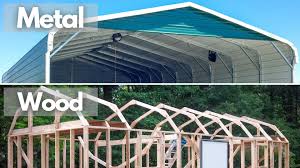The question of whether wood or metal is preferable for constructing a barn is often debated. Consideration should be given to various factors before a decision is made. Both materials possess distinct advantages and disadvantages that merit exploration.
Advantages of Wood
Wood has long been favored for its natural aesthetic appeal and traditional charm. Barns constructed from wood blend seamlessly into rural landscapes and offer a rustic ambiance. Additionally, wood is known for its insulative properties, providing a comfortable environment for livestock and storage.
Disadvantages of Wood
Despite its aesthetic appeal, wood requires regular maintenance to withstand the elements. Over time, exposure to moisture and insects can lead to decay and structural damage, necessitating repairs and replacement. Moreover, wood is susceptible to fire, posing a significant risk in agricultural settings.
Advantages of Metal
Metal barns, on the other hand, are valued for their durability and low maintenance requirements. Typically constructed from galvanized steel or aluminum, metal barns offer superior resistance to weather conditions, including rain, snow, and wind. They are also less vulnerable to pests and do not require painting or staining.
Disadvantages of Metal
However, metal barns may lack the aesthetic appeal of their wooden counterparts. Their industrial appearance may not harmonize as well with natural surroundings, particularly in rural landscapes. Furthermore, metal can conduct heat and cold more readily than wood, potentially affecting the internal temperature of the barn.
Considerations for Longevity
When evaluating the longevity of wood versus metal barns, several factors come into play. Wood, while susceptible to decay, can be treated with preservatives and maintained to extend its lifespan. Metal, although inherently more durable, may corrode over time if not properly maintained. Regular inspections and preventive measures are essential to ensure the structural integrity of both types of barns.
Environmental Impact
From an environmental standpoint, both wood and metal have distinct ecological footprints. Wood is a renewable resource, provided it is sourced from sustainably managed forests. Its production involves less energy consumption compared to metal. Conversely, metal barns can be recycled at the end of their lifespan, reducing waste and conserving resources.
Cost Considerations
Cost is a significant factor in determining the feasibility of constructing a barn. Wood, despite its maintenance requirements, is often more affordable initially than metal. However, ongoing upkeep costs should be factored into the long-term budget. Metal barns, while pricier upfront, offer potential savings in maintenance and replacement expenses over time.
Regulatory and Zoning Considerations
Before proceeding with construction, it is crucial to consider local regulations and zoning requirements. Some areas may have restrictions on building materials or specific codes governing barn construction. Compliance with these regulations ensures that the barn meets safety standards and avoids potential legal issues in the future.
Conclusion
In conclusion, the choice between wood and metal for constructing a barn depends on a variety of factors, including aesthetic preferences, maintenance considerations, environmental impact, and budget constraints. Both materials offer unique advantages and disadvantages that should be carefully weighed before making a decision. Ultimately, the best choice will align with the specific needs and priorities of the barn owner, ensuring a functional and durable structure for years to come.










